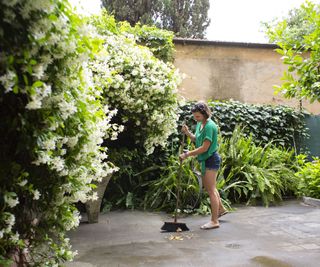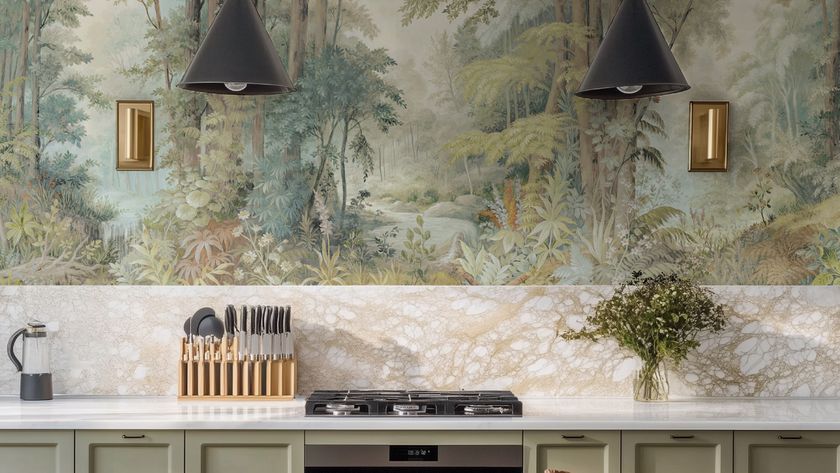How to clean patio slabs — with and without a pressure washer
The start of spring is the perfect time to tidy up your patio and make it look inviting

Heading into spring is the perfect time to look at how to clean patio slabs, and there are a few methods to choose from which will see the job done.
Getting rid of months, perhaps years, of accumulated grime can seem like a daunting task, especially if you live near a busy road where dirt is more likely to accumulate from passing traffic, or your patio is in an area where there might be high moss or algae growth.
But fear not, we are here to help with expert advice on the steps you should take, the equipment you need, the best pressure washers you may require, and anything else you need to be aware of.
How to clean patio slabs without a pressure washer

It's easy to know how to clean patio slabs without a pressure washer according to garden maintenance expert at Allan's Gardens Jane Dobbs.
"It's best to clean your patio ideas during a dry spell when it's unlikely to rain. Cleaning a patio on a sunny day lets the surface dry faster. Also, the sun disinfects and brightens patios naturally," says Jane.
So instead of buying a new one, try the budget patio idea of sprucing up your existing one. Jane outlines her method below, as well as the tools needed for the job.
What you will need:
- Cleaning detergent of your choice (try Patio Magic! 16491 Concentrate at Amazon) Or try a homemade solution (see our FAQs.
- Bucket
- Stiff scrub brush
- Garden hose with spray nozzle
- Protective gloves
Shop patio cleaner

Removes algae, mould and mildew from most garden surfaces and is supposed to prevent it from reappearing, giving you long lasting results.
- Clear the space: As with how to clean decking, getting rid of any furniture, plant pots, or debris from the patio is the first step. Clear a space so you can work. To remove loose dirt, leaves, and other debris, sweep the patio or brush it. It's easy to do with a stiff-bristled broom or brush.
- Prepare your cleaning solution: Use warm water and a patio cleaner or detergent to create a cleaning solution. Mix warm water with a patio cleaner or detergent in a bucket but follow the manufacturer's dilution ratios.
- Or make your own: If you don't have any of these, you can make a homemade solution with vinegar, baking soda, or mild dish soap. Note that vinegar is unsuitable for limestone.
- Scrub the surface: Dip a stiff brush into the cleaning solution and scrub the patio surface. Focus on spots with stubborn stains, algae, or moss. A scrubbing pad might help with tough stains.
- Rinse it down: Once you're done scrubbing, rinse off your patio with a garden hose or bucket of clean water. For a final rinse, you can use a mop or sponge soaked in clean water. It'll help remove any dirt or soap residue left over.

Responsible for leading the gardening team at Allan's Gardeners, a landscaping and garden maintenance business, patio cleaning is among the services they offer.
How to clean patio slabs with a pressure washer

"A pressure washer is a quick and easy way to clean a patio. It's also a good choice if you have plants nearby or a household with kids or pets," says Thomas Goodman property expert at MyJobQuote.
This is because a pressure washer uses only water rather than chemicals which can damage your plants.
Thomas outlines his method on how to clean patio slabs with a pressure washer below.
What you will need:
- Old clothes and shoes to wear
- Stiff broom
- Work gloves
- Goggles
- Pressure washer (for example see our Cobra PW18024V cordless pressure washer review)
- Lance or rotary brush attachment
- Water supply
- Cleaning fluid (optional)
Shop pressure washers

A really inexpensive option as pressure washers go. And the reviews on the site are encouraging.

One of Karcher's best-selling pressure washers. Check out our full thoughts on our Kärcher K4 Premium Power Control Pressure Washer Review.
- Clear furniture: remove pots and other items off your patio, so you don’t need to stop mid-way through cleaning. Move them a good distance away to ensure they don’t get blasted or splashed by the pressure washer.
- Sweep away debris: Get a stiff broom and sweep up the loose dirt and garden debris.
- Set up pressure washer: Hook up your pressure washer (see the best Karcher pressure washers) to the water supply and connect a suitable attachment such as a lance or rotary brush. If your patio is really dirty, you may want to add detergent to the machine or spray it over your patio. But in most cases, this shouldn’t be necessary.
- Adjust the pressure: To avoid damaging your slabs, you may need to adjust the pressure. If you’re using a lance, be sure to hold it at an angle and away from the surface of the patio, so you don’t cause pitting. As natural stone patios are particularly susceptible to this, you do need to take care with slabs made from materials such as limestone and sandstone.
- Work methodically across your patio: Go from one end to the other. This will ensure you don’t miss any sections. If you’re using a lance, adopt a sweeping motion to avoid blasting your slabs too heavily.
- Mind the joins: You also need to be careful as you work over the joins of the slabs as you can damage the mortar or push out the grouting compound. You may find working diagonally across the slabs minimises this risk.

Thomas Goodman has worked as a property and construction expert for MyJobQuote for six years and has worked in the construction industry for over twenty years. Thomas continues to work on building projects, while also providing expert construction and property advice to industry professionals and DIY enthusiasts.

FAQs
When is a good time to clean a patio?
"Once the weather has warmed up, you can be sure your wet patio won’t freeze over. Cleaning it during springtime will mean it’s ready to enjoy over summer. Plus, the temperatures won’t be too hot to work in and any cleaning solutions you’re using will have time to work rather than simply evaporate. Pick a dry day to make it easier to sweep up the debris from your patio.," says Thomas Goodman, property expert at MyJobQuote.
"Avoid extreme heat or cold when cleaning your patio, as it will affect the effectiveness of cleaning solutions. Pick a day with calm winds to make cleaning easier. You don't want to clean a patio on a windy day, as debris and cleaning solutions might get blown all over," says garden maintenance expert Jane Dobbs.
Once you've finished cleaning, think about other ways you can smarten up your patio. Perhaps try a new patio edging idea or try painting patio paving slabs, for a complete transformation.
What is the best DIY patio cleaner?
According to Tom Clifford, from Gardenstone, washing powder makes an effective and affordable DIY solution for how to clean patio slabs:
"The chemicals in the washing powder are strong enough to remove dirt, moss and stains without causing any damage to the surface of the paving. Simply, create a mixture of warm water and washing powder, then pour it over the surface of the patio and leave to sit for ten to fifteen minutes."
"Next, using a gentle bristle brush scrub the surface of your patio from the outside inwards, once completed make sure to rinse the mixture off thoroughly. "
With all cleaning solutions, you should ensure your patio stone can sustain the type of chemicals you are using on it. More delicate stones, like limestone, can easily be damaged so I recommend testing the solution on a small area of your patio first."

Tom has been in the garden landscaping business for over 13 years making him an expert in garden design, paving and maintenance. He is the director of Gardenstone Limited, which specialises in garden edging, patio paving, gravel and walling materials.
Can you clean patio slabs with washing up liquid?
"If sealed and installed properly, all your patio tiles should need to get clean is hot soapy water. Diluting household washing-up liquid in warm tap water is gentle enough not to damage your tiles, yet effective at lifting dirt and stains," says tile and stone expert at Stone Superstore, Molly Woodward-Moor.
"Stubborn marks may require additional elbow grease but, better yet, consider finishing your clean with a jet wash over your tiles for an efficient, low-effort way to get them back to looking fresh and pristine."
"Whilst washing up liquid can be effective, for those looking for guaranteed results, it’s best to consider purchasing specific cleaning products designed particularly for patio tiles," says Molly.

Interior Designer, and creative director at Stone Superstore, online porcelain tile and natural stone tile business, Molly Woodward-Moor has a wealth of design and home development expertise alongside her First Class BA (Honours) degree in Interior Design.
Does white vinegar clean paving slabs?
This works well on some paving slabs but can damage others. "White vinegar, mixed with equal parts of water, is an effective non-toxic cleaning solution for how to clean patio slabs, that is more of an environmentally friendly option over harsh chemicals," says tile and stone expert Molly Woodward-Moor.
"However, take precaution when using this solution on tiles - if used excessively, the acidity can lead to eventual surface damage on some material types. It is important not to use white vinegar on natural stones like limestone, marble, or travertine. These stones will react to the acidity of the vinegar, leading to burning or etch marks on the surface," cautions Molly.
Is bleach good for cleaning paving slabs?
"While bleach is known to be particularly effective at lifting stains around the house, such as for mould removal, it can cause some issues when used excessively on cleaning patio slabs," says tile and stone expert Molly Woodward-Moor.
"Bleach is a harsh chemical that can damage natural stone tiles by slowly stripping the surface which can then permanently mark or weaken your tiles. And even though some paving tiles are extremely durable, it’s still best to avoid using chemical cleaners containing ammonia, bleach or acids, which can slowly fade tile and grout colour," she says.
"Not to mention, using bleach is no good for organic gardening, being extremely harmful to the environment so it's best kept for indoor surface use, away from natural wildlife."
It's worth mentioning that frequent washing can help prevent dirt and grime settling into cracks more permanently.
Patio cover ideas will also help protect your patio from the weather somewhat, meaning they won't get as dirty.
Get the Homebuilding & Renovating Newsletter
Bring your dream home to life with expert advice, how to guides and design inspiration. Sign up for our newsletter and get two free tickets to a Homebuilding & Renovating Show near you.

Teresa was part of a team that launched Easy Gardens in 2018 and worked as the Editor on this magazine. She has extensive experience writing and editing content on gardens and landscaping on brands such as Homes & Gardens, Country Homes & Interiors and Living Etc magazine. She has developed close working relationships with top landscape architects and leading industry experts, and has been exposed to an array of rich content and expertise.
In 2020 Teresa bought her first home. She and her partner worked alongside architects and builders to transform the downstairs area of her two bedroom Victorian house in north London into a usable space for her family. Along the way she learned the stresses, woes and joys of home renovation, and is now looking to her next project, landscaping the back garden.

























